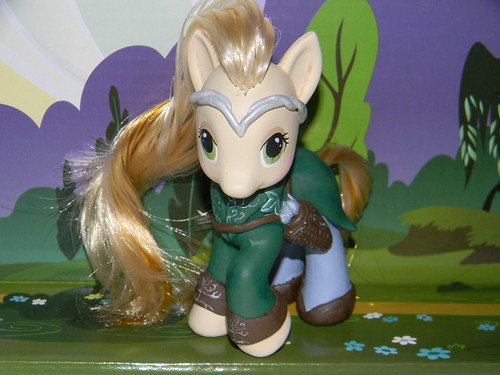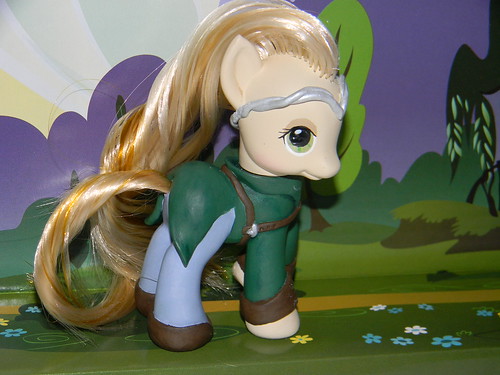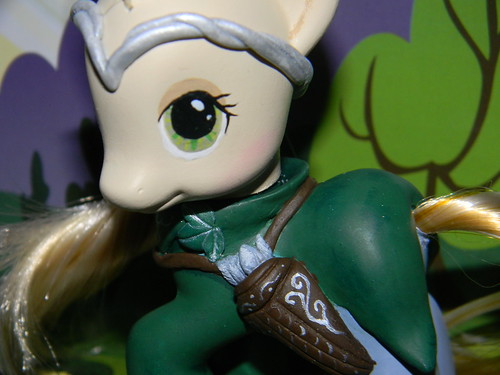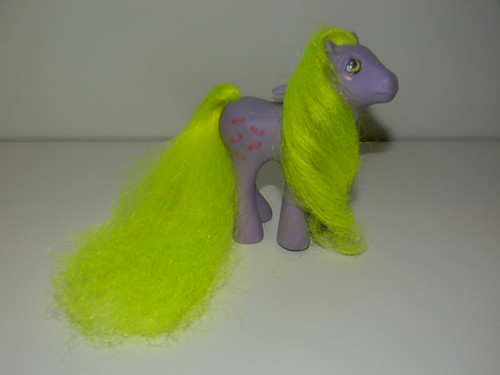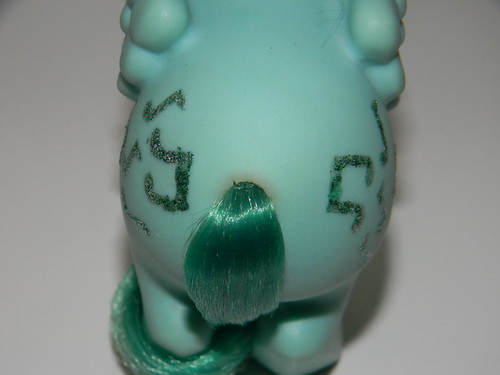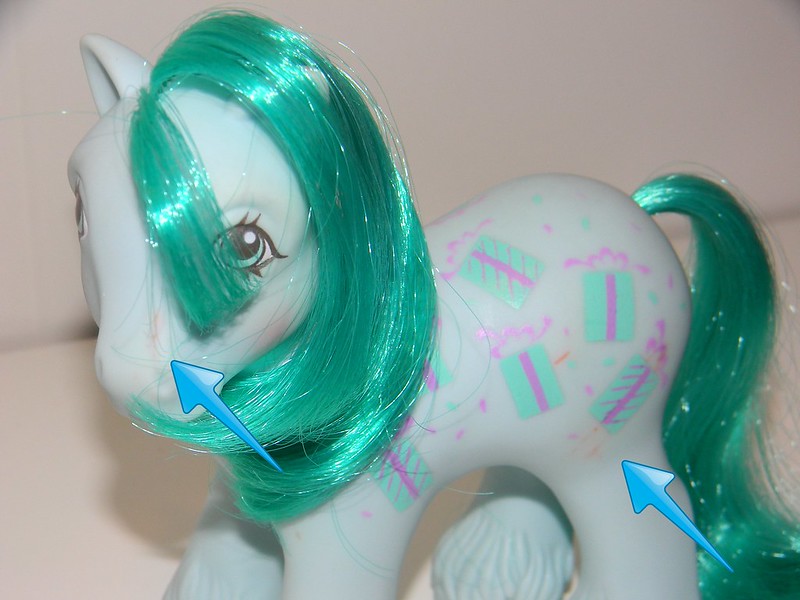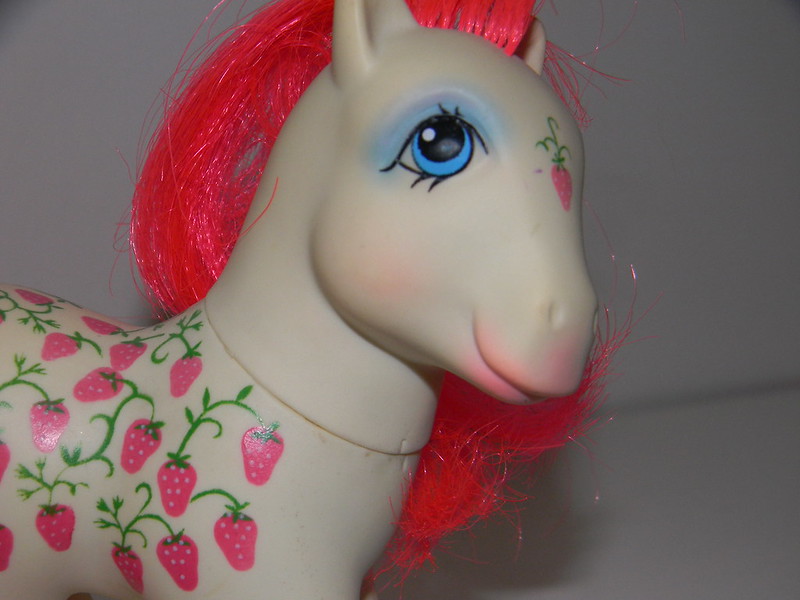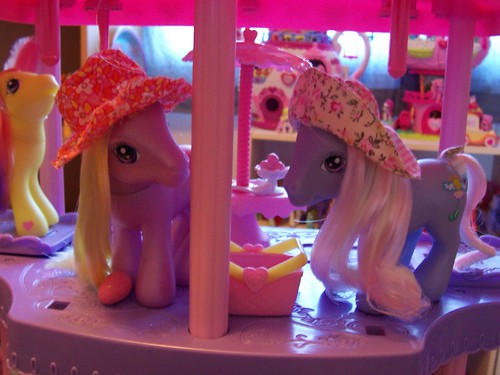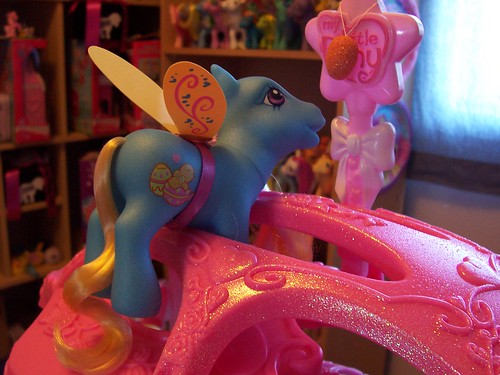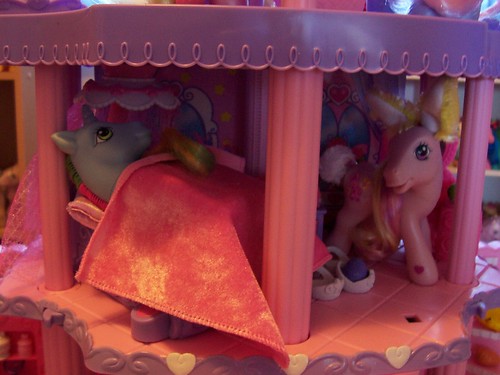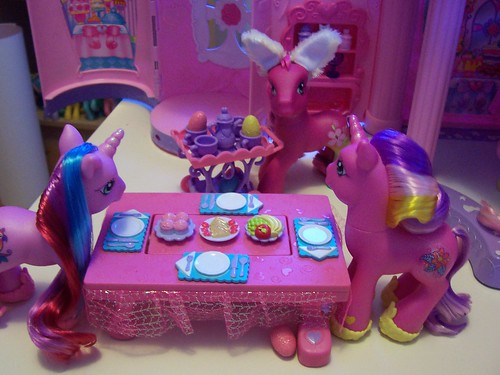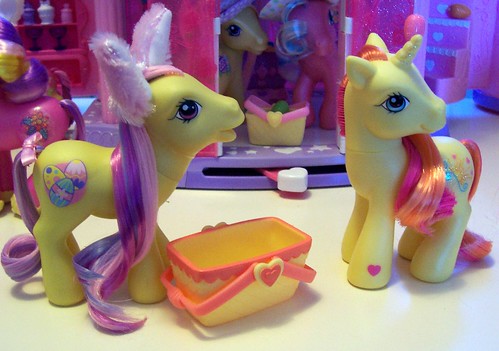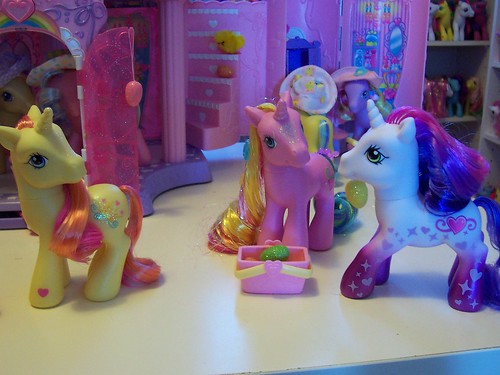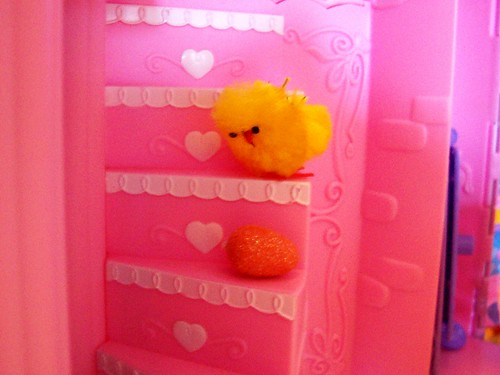This is Lauriel, the custom I made for the Arena Fantasy Swap (2015).
Lauriel is a Tolkien-style Elf. She divides her time mainly between Lorien and Mirkwood, as she has relatives in both places. But she is also a Ranger, and makes frequent trips to visit Elrond Half-Elven in Rivendell. She is frequently traveling among the mountains and valleys of Middle Earth, battling the forces of the Dark Lord with her bow and quiver.
Her clothes, bow, and the points on her ears have been sculpted from Apoxie, and she's been fully repainted and sealed. Her hair is a blend of Buttercreme, Golden Goddess, and Golden Sun. Naturally, when I discovered my partner in the swap was a big Tolkien fan, I had to make her an elf-pony. It's not for nothing that I chose the username that I did.
Elf
Friday, 24 April 2015
Friday, 17 April 2015
Damaged Goods Part 5: The Frizzies and other hair issues
Ah, the First World problems of a Collector. Those of us who collect
vintage (and modern) toys tend to get a little obsessive about flaws,
problems, and wear. What can we live with, what won't we allow across
the threshold of the Pony Room?
The unfortunate truth about vintage Ponies is that very few of these 30+ year old toys has made it this far without sustaining some kind of damage. The even more unfortunate truth is that we're only going to see more damage coming out on these beloved friends as time passes. In the next few weeks, I'm going to explore some of the more common problems that we see in vintage ponies, with an eye toward educating new collectors and warning FIM fans about what they might expect from their Ponies in the coming years.
Frizz
Nylon hair that has been brushed, washed, and generally played with repeatedly can become damaged and frizzy. This is especially common on ponies that were sold with curly hair. Sometimes you look at a pony with frizzy hair and think it's a lost cause, but I've found that it's always good to try and repair her anyway, sometimes you'll be surprised at the results.
Washing and conditioning the hair is a good first step. Often, you'll begin to see improvement right away with just the first application of conditioner. If the hair is quite damaged, it may be worthwhile to leave the conditioner on for a prolonged period, perhaps even several days. If you are still not happy with the state of the hair, it is possible to improve it further using a straightening iron. It is important to keep the hair wet and full of conditioner, and to use a low heat setting for there is a danger that the hair could burn. Some Nirvana ponies have particularly brittle hair, so this step might not always be a good idea. Another option is to curl the hair, as this can help to hide some of the frizziness. And, of course, rehairing is also an option if the hair cannot be saved.
Rust
Rust can be a common problem on any generation of pony. Most commonly, the metal washer and clamp that hold the tail in place will rust when they get wet. If left untreated, the washer can actually rust to the point where it disintegrates. The evidence of rust can often be seen on the outside of the pony, where the body and hair have become discoloured, as can be seen above. The rust can even spread throughout the body, causing the pony to appear dingy or discoloured from the outside.
The best treatment for rust is to remove the rusty washer and clamp. Toothpaste, especially whitening toothpaste, is a good cleaning agent, but keep in mind that it can cause the hair to discolour, especially fading pink hair. Be sure to clean right down into the feet using a bottle brush or q-tip. Allow the pony to dry thoroughly before putting her back together, so you can avoid further issues down the road. A plastic zip-tie or similar device can replace the washer and clamp, and won't cause rust issues later.
Discolouration
Some of the brighter colours of hair can cause discolouration to the body of the pony. The Chartreuse colour above is especially bad for this. Dry, it is normally fairly safe, but as soon as it gets wet the colour becomes unstable and it can bleed. The dye can quickly stain the body, so it is important to ensure that the wet hair does not sit directly against the body, place a few layers of paper towel between the body and hair to prevent damage.
As I mentioned above, this "Electric Banana" colour is fairly safe when dry, but it can discolour the body around the tail hole and hair plugs simply through prolonged contact. What initially appears to be the reflection of the bright colour against the body can prove to be discolouration. This type of discolouration is minor and difficult if not impossible to repair. However, stains from the hair on other parts of the pony may be removed through sunfading. It is important, however, to cover all parts of the pony you do not want to fade, and to do some research in advance. Certain ponies are prone to "burning" (turning brown) if left in the sun.
Elf
The unfortunate truth about vintage Ponies is that very few of these 30+ year old toys has made it this far without sustaining some kind of damage. The even more unfortunate truth is that we're only going to see more damage coming out on these beloved friends as time passes. In the next few weeks, I'm going to explore some of the more common problems that we see in vintage ponies, with an eye toward educating new collectors and warning FIM fans about what they might expect from their Ponies in the coming years.
Frizz
Nylon hair that has been brushed, washed, and generally played with repeatedly can become damaged and frizzy. This is especially common on ponies that were sold with curly hair. Sometimes you look at a pony with frizzy hair and think it's a lost cause, but I've found that it's always good to try and repair her anyway, sometimes you'll be surprised at the results.
Washing and conditioning the hair is a good first step. Often, you'll begin to see improvement right away with just the first application of conditioner. If the hair is quite damaged, it may be worthwhile to leave the conditioner on for a prolonged period, perhaps even several days. If you are still not happy with the state of the hair, it is possible to improve it further using a straightening iron. It is important to keep the hair wet and full of conditioner, and to use a low heat setting for there is a danger that the hair could burn. Some Nirvana ponies have particularly brittle hair, so this step might not always be a good idea. Another option is to curl the hair, as this can help to hide some of the frizziness. And, of course, rehairing is also an option if the hair cannot be saved.
Rust
Rust can be a common problem on any generation of pony. Most commonly, the metal washer and clamp that hold the tail in place will rust when they get wet. If left untreated, the washer can actually rust to the point where it disintegrates. The evidence of rust can often be seen on the outside of the pony, where the body and hair have become discoloured, as can be seen above. The rust can even spread throughout the body, causing the pony to appear dingy or discoloured from the outside.
The best treatment for rust is to remove the rusty washer and clamp. Toothpaste, especially whitening toothpaste, is a good cleaning agent, but keep in mind that it can cause the hair to discolour, especially fading pink hair. Be sure to clean right down into the feet using a bottle brush or q-tip. Allow the pony to dry thoroughly before putting her back together, so you can avoid further issues down the road. A plastic zip-tie or similar device can replace the washer and clamp, and won't cause rust issues later.
Discolouration
Some of the brighter colours of hair can cause discolouration to the body of the pony. The Chartreuse colour above is especially bad for this. Dry, it is normally fairly safe, but as soon as it gets wet the colour becomes unstable and it can bleed. The dye can quickly stain the body, so it is important to ensure that the wet hair does not sit directly against the body, place a few layers of paper towel between the body and hair to prevent damage.
As I mentioned above, this "Electric Banana" colour is fairly safe when dry, but it can discolour the body around the tail hole and hair plugs simply through prolonged contact. What initially appears to be the reflection of the bright colour against the body can prove to be discolouration. This type of discolouration is minor and difficult if not impossible to repair. However, stains from the hair on other parts of the pony may be removed through sunfading. It is important, however, to cover all parts of the pony you do not want to fade, and to do some research in advance. Certain ponies are prone to "burning" (turning brown) if left in the sun.
Elf
Friday, 10 April 2015
Damaged Goods Part 4: Marks and Ink
Ah, the First World problems of a Collector. Those of us who collect
vintage (and modern) toys tend to get a little obsessive about flaws,
problems, and wear. What can we live with, what won't we allow across
the threshold of the Pony Room?
The unfortunate truth about vintage Ponies is that very few of these 30+ year old toys has made it this far without sustaining some kind of damage. The even more unfortunate truth is that we're only going to see more damage coming out on these beloved friends as time passes. In the next few weeks, I'm going to explore some of the more common problems that we see in vintage ponies, with an eye toward educating new collectors and warning FIM fans about what they might expect from their Ponies in the coming years.
Saddle Sores or Highlighter Marks
These, usually bright pink, marks have been known as "highlighter" marks for years. More recently, collectors have adopted the more descriptive term "saddle sores" instead. These marks are often a result of contact with another piece of plastic that is not colour fast. G1 saddles, shoes, and other soft plastic accessories are known to cause this colour transfer. The only way of removing these stains is through sunfading, which has its own set of challenges, as mentioned last week.
G3 ponies had similar issues with cloth accessories that were not colour safe. It is entirely possible and likely that G4 ponies may encounter the same issues, either with fabric or plastic accessories. The best way to avoid these issues is by not displaying accessories on a pony for an extended period of time.
Pen and Ink
Ink marks are also, unfortunately, common on 2nd hand ponies. Apparently there were a lot of budding customizers playing with ponies in their childhood.
Ink marks often require sunfading to remove them. However, it is always a good idea to try to remove them with either a Magic Eraser or acetone. I've had numerous instances where marks that appeared to be permanent ink were actually faded or removed using one of these products. It's worth a shot.
"Makeup"
"Makeup" is another common problem on G1s. Pony makeup was actually sold at various times in the G1 era, and this probably encouraged kids to try their hand at it. Whether or not you can remove these stains will depend greatly on what material was used. If it was the "pony makeup" that was sold by Hasbro, there's a good chance that a general cleaning will remove some of it. However, I've seen many instances where a more permanent material (ink or paint) was used, and these will stain the body permanently.
Regrind
Perhaps the worst bane of the pony collector's existence. As a cost saving measure, Hasbro would sometimes grind down old plastic to mix with new plastic batches. The batch was dyed to the colour required and the molds cast. However, the old plastic has proved to be less colour fast than the newer plastic, and as a result a pony can develop discoloured blotches on her body.
Some ponies will develop spots of regrind (most often bright pink). Some will gradually discolour until the entire pony is a different colour. There is no way to correct this colour change.
Elf
The unfortunate truth about vintage Ponies is that very few of these 30+ year old toys has made it this far without sustaining some kind of damage. The even more unfortunate truth is that we're only going to see more damage coming out on these beloved friends as time passes. In the next few weeks, I'm going to explore some of the more common problems that we see in vintage ponies, with an eye toward educating new collectors and warning FIM fans about what they might expect from their Ponies in the coming years.
Saddle Sores or Highlighter Marks
These, usually bright pink, marks have been known as "highlighter" marks for years. More recently, collectors have adopted the more descriptive term "saddle sores" instead. These marks are often a result of contact with another piece of plastic that is not colour fast. G1 saddles, shoes, and other soft plastic accessories are known to cause this colour transfer. The only way of removing these stains is through sunfading, which has its own set of challenges, as mentioned last week.
G3 ponies had similar issues with cloth accessories that were not colour safe. It is entirely possible and likely that G4 ponies may encounter the same issues, either with fabric or plastic accessories. The best way to avoid these issues is by not displaying accessories on a pony for an extended period of time.
Pen and Ink
Ink marks are also, unfortunately, common on 2nd hand ponies. Apparently there were a lot of budding customizers playing with ponies in their childhood.
Ink marks often require sunfading to remove them. However, it is always a good idea to try to remove them with either a Magic Eraser or acetone. I've had numerous instances where marks that appeared to be permanent ink were actually faded or removed using one of these products. It's worth a shot.
"Makeup"
"Makeup" is another common problem on G1s. Pony makeup was actually sold at various times in the G1 era, and this probably encouraged kids to try their hand at it. Whether or not you can remove these stains will depend greatly on what material was used. If it was the "pony makeup" that was sold by Hasbro, there's a good chance that a general cleaning will remove some of it. However, I've seen many instances where a more permanent material (ink or paint) was used, and these will stain the body permanently.
Regrind
 |
| Regrind and normal Cloud Puff courtesy of Teddy |
Some ponies will develop spots of regrind (most often bright pink). Some will gradually discolour until the entire pony is a different colour. There is no way to correct this colour change.
Elf
Friday, 3 April 2015
Happy Easter
Happy Long Easter Weekend! Here's an older display I did several years ago, for your viewing enjoyment, while you recover from your chocolate sugar high.
One early Easter morning, the Spring Ponies decided to pay a surprise visit to the castle in Unicornia and play Easter Bunny. They snuck into the castle and started hiding eggs here, there, and everywhere...
And I mean *everywhere*...
The unicorns were not quite sure what to make of this. Some of them were confused...
But others got pretty enthusiastic about hunting for chocolate eggs!
Happy Egg Hunt!
Elf
One early Easter morning, the Spring Ponies decided to pay a surprise visit to the castle in Unicornia and play Easter Bunny. They snuck into the castle and started hiding eggs here, there, and everywhere...
And I mean *everywhere*...
The unicorns were not quite sure what to make of this. Some of them were confused...
But others got pretty enthusiastic about hunting for chocolate eggs!
Happy Egg Hunt!
Elf
Subscribe to:
Comments (Atom)

